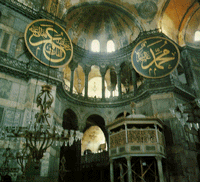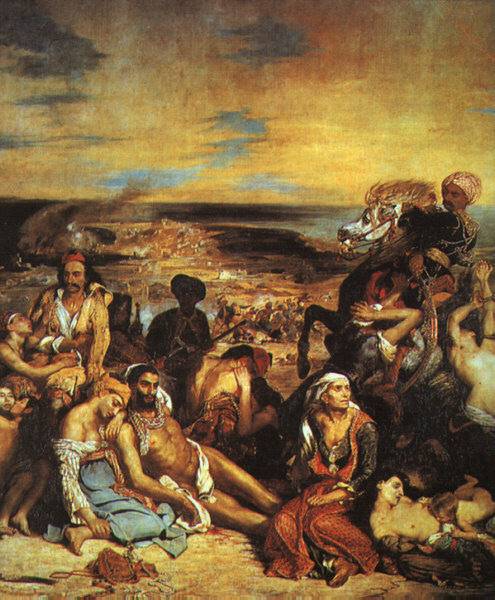Scene: Turks terrorize the Byzantines
A depiction of the Ottoman Turks’ conquest of the Byzantine Christians and their holy sites:
Once the emperor and his badly outnumbered soldiers were slain on the walls of Constantinople, bands of Turks went on a rampage. Pillaging and killing went on for three days. Thousands of civilians were enslaved, soldiers fought over boys and young women. The blood ran in rivers down the steep streets from the heights of Petra toward the Golden Horn. All the treasures of the Imperial Palace were carried off. Books and icons were burnt once the jeweled covers and frames had been wrenched off. In the monastery of the Holy Savior, the invaders first destroyed the icon of the Mother of God, the Hodigitria, the holiest icon in all Byzantium, painted – so men said – by Sanit Luke himself. When the Turks burst into the Hagia Sophia,
The worshippers were trapped. A few of the ancient and infirm were killed on the spot; but most of them were tied or chained together. Many of the lovlier maidens and youths and many of the richer-clad nobles were almost torn to death as their captors quarrelled over them. The priests went on chanting at the altar till they too were taken…The inhabitants were carried off along with their possessions. Anyone who collapsed from frailty was slaughtered, together with a number of infants who were held to be of no value…[Byzantium] was now half in ruins, emptied and deserted and blackened as though by fire, and strangely silent. Wherever the soldiers had been there was desolation. Churches had been desecrated and stripped; houses were no longer habitable and shops and stores battered and bare. The Sultan himself as he rode through the streets had to be moved to tears. [Sir Steven Runciman, The Fall of Constantinople, 1453, Cambridge University Press, 1969]
(interior of Hagia Sophia defaced with Islamic
medallions, symbols of domination)The difference between the Crusaders’ senseless debauchery and the Turks’ calculated barbarism is visible in the treatment of both subjects by a great painter. While acknowledging the shame of the “Entry of the Crusaders into Constantinople,” through his 1840 painting of the same name, it was Eugene Delacroix’s depiction of a Turkish monstrosity that became the Guernica of the nineteenth century. “The Massacre at Chios: Greek families awaiting death or slavery” is a masterpiece of horror depicting the systematic extermination of the entire population of an Aegean island, graphically illustrated how being a Greek, Armenian, Serb, or indeed any other Christian in the Ottoman Empire meant living in daily fear of murder, rape, torture, kidnap of one’s children, slavery, and genocide.
Excerpted from The Sword of the Prophet: Islam history, theology, impact on the world, by Serge Trifkovic, Regina Orthodox Press, 2002
“The Massacre at Chios: Greek families awaiting death or slavery,” Eugene Delacroix:
Related Posts:
Article: The Shell of the Great Church
Article: Why the Pope should call for the return of the Hagia Sophia


